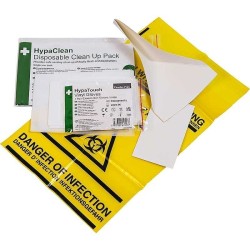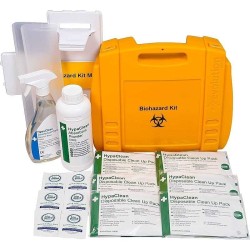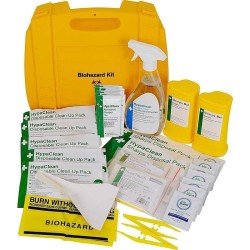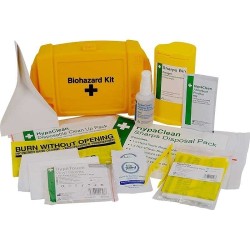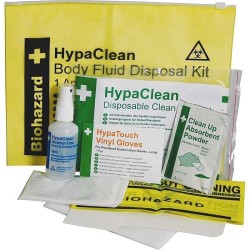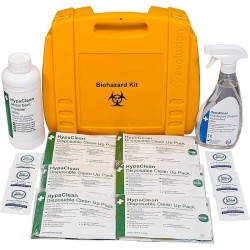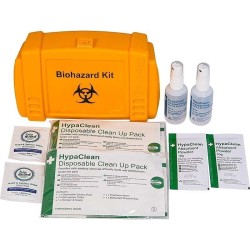Biohazard Kits
There are 9 products.
Active filters
About Biohazard Kits
Comprehensive Contamination Management and Infection Control
Biohazard kits provide comprehensive contamination cleanup and infection control supplies managing biological hazards across care facilities, workplaces, educational settings, and public environments throughout England, Scotland, Wales, and Northern Ireland. These essential safety kits contain items including disinfectants, personal protective equipment, absorbent materials, disposal bags, and cleaning supplies enabling safe management of blood, bodily fluids, and contaminated materials. Organisations rely on biohazard kits for blood spillage cleanup, bodily fluid contamination management, infection control, sharps disposal safety, and regulatory compliance with health and safety requirements. Modern biohazard kits incorporate features including comprehensive contents addressing typical contamination scenarios, appropriate disinfectants effective against bloodborne pathogens, suitable personal protective equipment, clear instructions supporting proper use, and convenient packaging enabling rapid deployment. The provision of biohazard kits demonstrates commitment to infection control, supports staff safety during contamination cleanup, enables professional hazard management, and fulfils health and safety obligations across environments with biological hazard risks throughout professional contexts.
The implementation of biohazard kits directly supports infection control, staff safety, and demonstration of professional hazard management. Blood and bodily fluid spillages present serious infection risks requiring immediate appropriate cleanup protecting staff and preventing disease transmission. Biohazard kits address these requirements by providing comprehensive supplies for safe contamination cleanup, protecting cleanup personnel through appropriate personal protective equipment, enabling effective disinfection preventing pathogen transmission, supporting safe disposal through appropriate bags and containers, and demonstrating professional health and safety management. Contamination scenarios include blood spillages in care facilities or public areas, bodily fluid incidents, sharps-related contamination, infection control situations, and biological hazard cleanup. Organisations benefit from biohazard kits through prevented infection transmission protecting staff and public, demonstrated regulatory compliance, professional hazard response capability, and enhanced safety culture. Modern biohazard kits incorporate features such as EPA-approved disinfectants, comprehensive personal protective equipment, and disposal guidance throughout England, Scotland, Wales, and Northern Ireland.
Selecting and implementing biohazard kits requires biological hazard risk assessment, appropriate kit specification, and integration with infection control and health and safety protocols across organisations throughout the UK. Health and safety, infection control, and facilities managers should evaluate biological hazard risks determining kit requirements, assess typical contamination scenarios, review regulatory obligations, and calculate adequate quantities for strategic placement. Kit selection should prioritise comprehensive contents addressing identified scenarios, effective disinfectants against bloodborne pathogens, appropriate personal protective equipment including gloves, aprons, and eye protection, absorbent materials, disposal bags and sharps containers where appropriate, clear instructions, and adequate quantities based on risk assessment. Implementation protocols must encompass strategic kit placement ensuring accessibility when contamination occurs, comprehensive staff training on biological hazard cleanup including personal protective equipment use and proper disinfection procedures, clear contamination response procedures, and documented kit management. Quality assurance measures should include regular kit inspections ensuring completeness, expiry date monitoring particularly disinfectants, contamination incident recording and investigation, and training verification. Modern biohazard kit management may incorporate digital training systems and incident analysis. Organisations must establish biological hazard procedures including immediate cleanup protocols, integrate with infection control and health and safety management, and maintain comprehensive documentation. Care facilities and public environments require strategically placed accessible biohazard kits. Staff education must address biological hazard risks, personal protective equipment importance, proper cleanup techniques, disposal procedures, and post-exposure protocols. Storage should enable rapid emergency access whilst preventing unauthorised use. By implementing biohazard kits alongside professional protocols, organisations throughout England, Scotland, Wales, and Northern Ireland demonstrate commitment to infection control compliance, staff safety during hazardous cleanup, regulatory health and safety obligations, and professional biological hazard management supporting prevention of disease transmission through appropriate contamination response across all working, care, and public environments with biological hazard risks.


